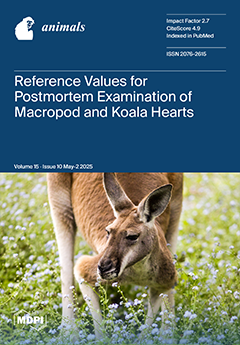Coccidiosis, caused by
Eimeria protozoa, is a severe intestinal parasitic disease that results in substantial economic losses to the global poultry industry annually. The gut microbiota plays a crucial role in host health, metabolism, immune function, and nutrient absorption in chickens. Recent studies have focused on the effects of
Eimeria tenella’s
(E. tenella) acute infection period on host health. However, recovery conditions, cecal microbiota composition, and functional differences in the ceca of chickens with varying resistance to
E. tenella remain poorly understood during the recovery period after infection. This study aimed to compare growth performance, cecal histopathology, and the cecal microbiota characteristics in control (R_JC), resistant (R_JR), and susceptible (R_JS) chickens during recovery, using metagenomic sequencing. The results revealed significant differences in both cecal tissue structure and growth performance between the different groups during recovery. Although no significant differences were observed in microbial alpha diversity among the groups, sequencing analysis highlighted notable changes in microbial composition and abundance.
Bacteroidetes,
Firmicutes, and
Proteobacteria were the predominant phyla in chicken cecal contents; however,
Firmicutes abundance was lower in the R_JS group than in the R_JC and R_JR groups. Further analysis, combining linear discriminant analysis effect size (LEfSe) and differential heatmap analysis, identified
Bacteroides_fluxus,
Ruminococcus_flavefaciens, and
Bacteroides_sp_CACC_737 as dominant microorganisms in the R_JR group (
p < 0.05) compared to both the R_JC and R_JS groups. In contrast,
Sutterella_sp_AM11-39,
Bacteroides_sp_43_108,
Mycobacterium,
Mycoplasma_arginini, and
Chlamydia dominated in the R_JS group, while
Butyricimonas,
Butyricimonas_sp_Marseille-P3923, and
Flavonifractor_plautii were significantly reduced in the R_JS group (
p < 0.05). Additionally, beneficial cecal microorganisms such as
Flavonifractor_sp__An10,
Pseudoflavonifractor, and
Faecalicoccus were significantly decreased in both the R_JR and R_JS groups (
p < 0.05) compared to the R_JC group. Predictive functional analysis using the KEGG and CAZy databases further indicated that the cecal microbiota in the R_JR group exhibited enhanced metabolism-related pathways, whereas these pathways were significantly diminished in the R_JS group, potentially influencing the recovery process from coccidial infection. These findings provide valuable insights into the cecal microbiota’s role during recovery from
E. tenella infection and deepen our understanding of the impact of coccidial infections on host health.
Full article






